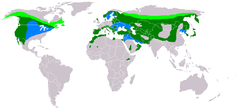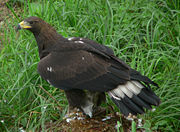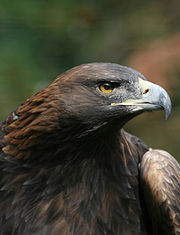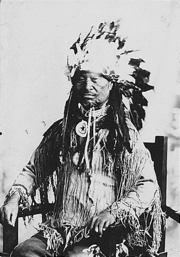
Golden Eagle
Background to the schools Wikipedia
SOS Children offer a complete download of this selection for schools for use on schools intranets. See http://www.soschildren.org/sponsor-a-child to find out about child sponsorship.
| Golden Eagle | |
|---|---|
 |
|
| Adult American Golden Eagle Aquila chrysaetos canadensis |
|
| Conservation status | |
|
Least Concern ( IUCN 3.1) |
|
| Scientific classification | |
| Kingdom: | Animalia |
| Phylum: | Chordata |
| Class: | Aves |
| Subclass: | Neornithes |
| Infraclass: | Neognathae |
| Superorder: | Neoaves |
| Order: | Falconiformes |
| Family: | Accipitridae |
| Genus: | Aquila |
| Species: | A. chrysaetos |
| Binomial name | |
| Aquila chrysaetos (Linnaeus, 1758) |
|
 |
|
| Light green = Breeding only Blue = Wintering only Dark green = All-year |
|
| Synonyms | |
|
Falco chrysaëtos Linnaeus, 1758 |
|
The Golden Eagle (Aquila chrysaetos) is one of the best known birds of prey in the Northern Hemisphere. Like all eagles, it belongs to the family Accipitridae. Once widespread across the Holarctic, it has disappeared from many of the more heavily populated areas. It has a wingspan averaging over 2 m (7 ft) and up to 1 m (3 ft) in body length.
Description
Adult Golden Eagles range considerably in size. The largest subspecies are among the largest eagles of the genus Aquila. Most subspecies of Golden Eagle vary in the range from 66 to 100 cm (26–40 in), wingspan can range from 150 to 240 cm (59–95 in), and weight is from 2.5 to 6.7 kg (5.5–13.4 lb). However, wild specimens of the largest subspecies in North America have been observed to be somewhat larger than that description, as the largest recorded weighed 9kg (20 lbs) and had a body length of 102 cm (40.1 in). As with many Falconiformes, females are considerably larger than males, in the case of the Golden Eagle they weigh one-fourth to one-third again as much as male birds.
The plumage colours range from black-brown to dark brown, with a striking golden-buff crown and nape, which give the bird its name. The upper wings also have an irregular lighter area. Immature birds resemble adults, but have a duller more mottled appearance. Also they have a white-banded tail and a white patch at the carpal joint, that gradually disappear with every moult until full adult plumage is reached in the fifth year
Taxonomy and systematics
This species was first described by Linnaeus in his 1758 Systema naturae as Falco chry saetos. The type locality is given simply as "Europa"; it was later fixed to Sweden.
The Golden Eagle is one of the large eagles in the genus Aquila, which are distributed almost worldwide. The latest research indicates it forms a worldwide superspecies with Verreaux's Eagle, Gurney's Eagle and the Wedge-tailed Eagle.
Subspecies and distribution
There are six living subspecies of Golden Eagle that differ slightly in size and plumage. They can be found in different parts of the world:
- Aquila chrysaetos chrysaetos (Linnaeus, 1758) – Eurasia except Iberian peninsula, east to western Siberia.
- Aquila chrysaetos canadensis (Linnaeus, 1758) – North America.
- Aquila chrysaetos daphanea Severtzov, 1888 – Southern Kazakhstan east to Manchuria and south-west China, also northern India and Pakistan.
- Aquila chrysaetos homeryi Severtzov, 1888 – Iberian peninsula and North Africa, east to Turkey and Iran.
- Aquila chrysaetos japonica Severtzov, 1888 – Japan and Korea.
- Aquila chrysaetos kamtschatica Severtzov, 1888 – Eastern Siberia, from the Altay to the Kamchatka Peninsula. Often included in A. c. canadensis.
The larger Middle Pleistocene Golden Eagles of France (and possibly elsewhere) are referred to a paleosubspecies Aquila chrysaetos bonifacti, and the huge specimens of the Late Pleistocene of Liko Cave ( Crete) have been named Aquila chrysaetos simurgh.
Ecology
Feeding
Golden eagle prey includes marmots, hares and mice, and sometimes birds, martens, foxes, young deer, and livestock including lambs and young goats. During winter months when prey is scarce, Golden Eagles scavenge on carrion to supplement their diet. Sometimes when no carrion is available golden eagles will hunt down owls, hawks, falcons, and wolverines. There are records of golden eagles killing Eurasian Eagle Owls and hawks. Golden Eagles have very good eyesight and can spot prey from a long distance. The talons are used for killing and carrying the prey, the beak is used only for eating. They often have a division of labour while hunting, one bird driving the prey towards its waiting partner. On the other hand, the size difference between males and females allows more unpaired birds to live off the land, helpful to maintain a sufficiently large population in this large and slowly-maturing bird.
Reproduction
Golden Eagles usually mate for life. They build several eyries within their territory and use them alternately for several years. These nests consist of heavy tree branches, upholstered with grass when in use. Old eyries may be 2 metres (6.6 ft) in diameter and 1 metre (3.3 ft) in height, as the eagles repair their nests whenever necessary and enlarge them during each use. If the eyrie is situated on a tree, supporting tree branches may break because of the weight of the nest. Certain other animals – birds and mammals too small to be of interest to the huge raptor – often use the nest as shelter. Their predators are just the right size for Golden Eagle prey, and therefore avoid active eyries.
The female lays two black eggs between January and September (depending on the locality). They start incubation immediately after the first egg is laid, and after 45 days on average the young hatch. They are entirely white and are fed for fifty days before they are able to make their first flight attempts and eat on their own. In most cases only the older chick survives, while the younger one dies without leaving the eyrie. This is due to the older chick having a few days' advantage in growth and consequently winning most squabbles for food. This strategy is useful for the species because it makes the parents' workload manageable even when food is scarce, while providing a reserve chick in case the first-born dies soon after hatching. Golden Eagles invest much time and effort in bringing up their young; once able to hunt on their own, most Golden Eagles survive many years, but mortality even among first-born nestlings is much higher, in particular in the first weeks after hatching
Status and conservation
At one time, the Golden Eagle lived in temperate Europe, North Asia, North America, North Africa and Japan. In most areas this bird is now a mountain-dweller, but in former centuries it also bred in the plains and the forests. In recent years it has started to breed in lowland areas again e.g. in Sweden and Denmark.
There was a great decline in Central Europe, and in central Europe, Golden Eagles are now essentially restricted to the Apennine, Alps and Carpathian Mountains. In Britain, there were about 420 pairs in 2007, the majority of these in the Scottish highlands, and between 1969 and 2004 they bred in the English Lake District. Golden Eagles can still often be seen soaring above mountains in Scotland, and are slowly returning to Northern England.
In Ireland, where it had been extinct due to hunting since 1912, efforts are being made to re-introduce the species. Forty-six birds were released into the wild in Glenveagh National Park, County Donegal, from 2001 to 2006, with at least three known female fatalities since then. It is intended to release a total of sixty birds, to ensure a viable population. In April 2007, a pair of Golden Eagles produced the first chick to be hatched in the Republic of Ireland in nearly a century. The previous attempt to help the birds breed at the Glenveagh National Park had failed.
In North America the situation is not as dramatic, but there has still been a noticeable decline. The main threat is habitat destruction which by the late 19th century already had driven Golden Eagles from some regions they used to inhabit. In the 20th century, organochloride and heavy metal poisonings were also commonplace, but these have declined thanks to tighter regulations on pollution.
Available habitat and food are the main limiting factor nowadays. Collisions with power lines have become an increasingly significant cause of mortality since the early 20th century. On a global scale, the Golden Eagle is not considered threatened by the IUCN mainly thanks to the large Asian and American populations.
In human culture
Falconry
Golden Eagles can be trained for falconry. In Kazakhstan, Kyrgyzstan, western Mongolia and China, Golden Eagles are still used to hunt foxes and wolves by Kazakh and Kyrgyz nomads; the bird is locally known as burkut or berkut. Foxes are killed outright by the eagles, but due to their size and strength wolves are usually held down while the falconer himself finishes the kill.
Heraldry
The Golden Eagle was model for the aquila, the standard of the Roman legions. It is featured in the national coat of arms of, Egypt, Mexico, Romania and many other countries.
Religion
The eagle is a sacred bird in some cultures and the feathers of the eagle are central to many religious and spiritual customs, especially amongst some Native Americans in the United States and First Nations in Canada, as well as among many of the peoples of Meso-America. Some Native American peoples revere eagles as sacred and the feathers and other parts of Bald and Golden Eagles feathers are often worn on Native American headdresses and have been compared to the Bible and crucifix of Christianity. Eagle feathers are often used in various Native ceremonies and are used to honour noteworthy achievements and qualities such as exceptional leadership and bravery.
Current United States eagle feather law (50 CFR 22) stipulates that only individuals of certifiable Native American ancestry enrolled in a federally recognized tribe are legally authorized to obtain eagle feathers for religious or spiritual use. Thus, the supply of eagle material for traditional ceremonial use can be guaranteed and ceremonial eagle items can be passed on as heirlooms by their traditional owners without the restrictions that would usually apply. Commercial trade in Golden Eagles or their feathers or body parts is not legalized by these exceptions.





